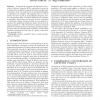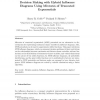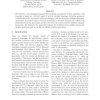63 search results - page 1 / 13 » Possibilistic Influence Diagrams |
ECAI
2006
Springer
13 years 8 months ago
2006
Springer
Abstract. In this article we present the framework of Possibilistic Influence Diagrams (PID), which allow to model in a compact form problems of sequential decision making under un...
EOR
2008
13 years 4 months ago
2008
Mixtures of truncated exponentials (MTE) potentials are an alternative to discretization for representing continuous chance variables in influence diagrams. Also, MTE potentials c...
UAI
2008
13 years 6 months ago
2008
This paper describes a new algorithm to solve the decision making problem in Influence Diagrams based on algorithms for credal networks. Decision nodes are associated to imprecise...
IJAR
2006
13 years 4 months ago
2006
We describe a new graphical language for specifying asymmetric decision problems. The language is based on a filtered merge of several existing languages including sequential valu...
UAI
2004
13 years 6 months ago
2004
Mixtures of truncated exponentials (MTE) potentials are an alternative to discretization for representing continuous chance variables in influence diagrams. Also, MTE potentials c...



